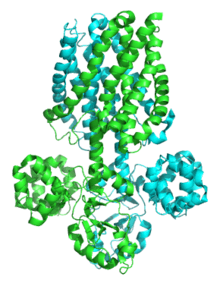Magnesium transporter E
| MgtE | |||||||||
|---|---|---|---|---|---|---|---|---|---|
 | |||||||||
| Identifiers | |||||||||
| Symbol | MgtE | ||||||||
| Pfam | PF01769 | ||||||||
| InterPro | IPR006667 | ||||||||
| TCDB | 1.A.26 | ||||||||
| OPM superfamily | 201 | ||||||||
| OPM protein | 2yvx | ||||||||
| |||||||||
Magnesium transporters E (MgtE) (TC# 1.A.26) are a family of transmembrane eubacterial MgtE magnesium transporters that are part of the TOG superfamily. Related regions are found also in archaeal and eukaryotic proteins. They have sizes that vary considerably from 311 residues for the Methanococcus thermoautotrophicum protein, 463 residues for a Synechocystis homologue, and 513 residues for the human homologue, SLC41A1. These proteins are capable of transporting Mg2+ and Co2+ but not Ni2+. Multiple alignments contain two highly conserved aspartates that may be involved in cation binding.
Human transporters from this family are SLC41A1, SLC41A2 and SLC41A3.
Structure and Mechanism
The Bacillus firmus transporter and several homologues examined have strongly charged, hydrophilic N-terminal domains (cytoplasmic) followed by a hydrophobic C-terminal domain with 5 putative transmembrane α-helical spanners. A central 100 residues resembles archaeal inositol monophosphate dehydrogenases.[2]
Kehres and Maguire suggest that the MgtE proteins are secondary carriers with inwardly directed polarity.[2] Hattori et al. have considered MgtE to function by a channel mechanism, providing evidence that the MgtE cytosolic domain acts as a Mg2+ sensor to regulate gating of the pore in response to the intracellular Mg2+ concentration.[3] This produces a mechanism for the maintenance of homeostasis conditions.[3] The cytosolic domain of MgtE undergoes a Mg2+-dependent structural change, which may gate the ion-conducting pore passing through the transmembrane domain.
Maruyama et al. showed that MgtE exhibits the channel-like electrophysiological properties, i.e., Mg2+ transport occurs in accordance to the electrochemical potential of Mg2+.[4] The Mg2+-permeation pathway opens in response to a decrease of the intracellular Mg2+ concentration, while it is completely closed at the intracellular Mg2+ concentration of 10 mM. The crystal structures of the MgtE dimer reveal that the Mg2+-sensing cytoplasmic region consists of the N and CBS domains. The Mg2+-bound state adopts a compact, globular conformation, which is stabilized by the coordination of a number of Mg2+ ions between these domains. On the other hand, in the Mg2+-unbound state, these domains are far apart, and fixed by the crystal packing.
Transport Reaction
The transport reaction catalyzed by MgtE proteins is:
- Mg2+ (or Co2+) (out) → Mg2+ (or Co2+) (in)
References
- ↑ Hattori, M.; Iwase, N.; Furuya, N.; Tanaka, Y.; Tsukazaki, T.; Ishitani, R.; Maguire, M. E.; Ito, K.; Maturana, A.; Nureki, O. (2009). "Mg2+-dependent gating of bacterial MgtE channel underlies Mg2+ homeostasis". The EMBO Journal. 28 (22): 3602–3612. doi:10.1038/emboj.2009.288. PMC 2782099
 . PMID 19798051.
. PMID 19798051. - 1 2 Kehres, David G.; Maguire, Michael E. (2002-09-01). "Structure, properties and regulation of magnesium transport proteins". Biometals: An International Journal on the Role of Metal Ions in Biology, Biochemistry, and Medicine. 15 (3): 261–270. ISSN 0966-0844. PMID 12206392.
- 1 2 Hattori, Motoyuki; Iwase, Norihiko; Furuya, Noritaka; Tanaka, Yoshiki; Tsukazaki, Tomoya; Ishitani, Ryuichiro; Maguire, Michael E.; Ito, Koichi; Maturana, Andres (2009-11-18). "Mg(2+)-dependent gating of bacterial MgtE channel underlies Mg(2+) homeostasis". The EMBO journal. 28 (22): 3602–3612. doi:10.1038/emboj.2009.288. ISSN 1460-2075. PMC 2782099
 . PMID 19798051.
. PMID 19798051. - ↑ Maruyama, Tatsuro; Imai, Shunsuke; Osawa, Masanori; Hattori, Motoyuki; Ishitani, Ryuichiro; Nureki, Osamu; Shimada, Ichio (2013-04-01). "Backbone resonance assignments for the cytoplasmic region of the Mg(2+) transporter MgtE in the Mg (2+)-unbound state". Biomolecular NMR assignments. 7 (1): 93–96. doi:10.1007/s12104-012-9385-y. ISSN 1874-270X. PMID 22477092.
This article incorporates text from the public domain Pfam and InterPro IPR006667
As of this edit, this article uses content from "1.A.26 The Mg2+ Transporter-E (MgtE) Family", which is licensed in a way that permits reuse under the Creative Commons Attribution-ShareAlike 3.0 Unported License, but not under the GFDL. All relevant terms must be followed.